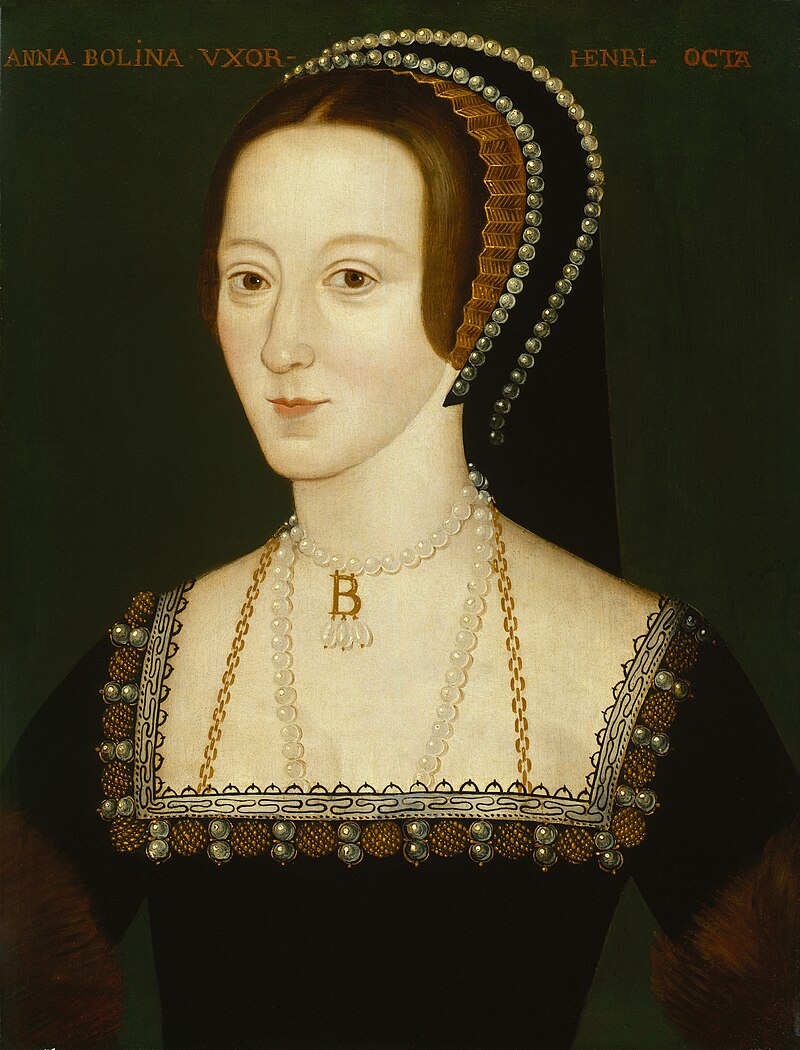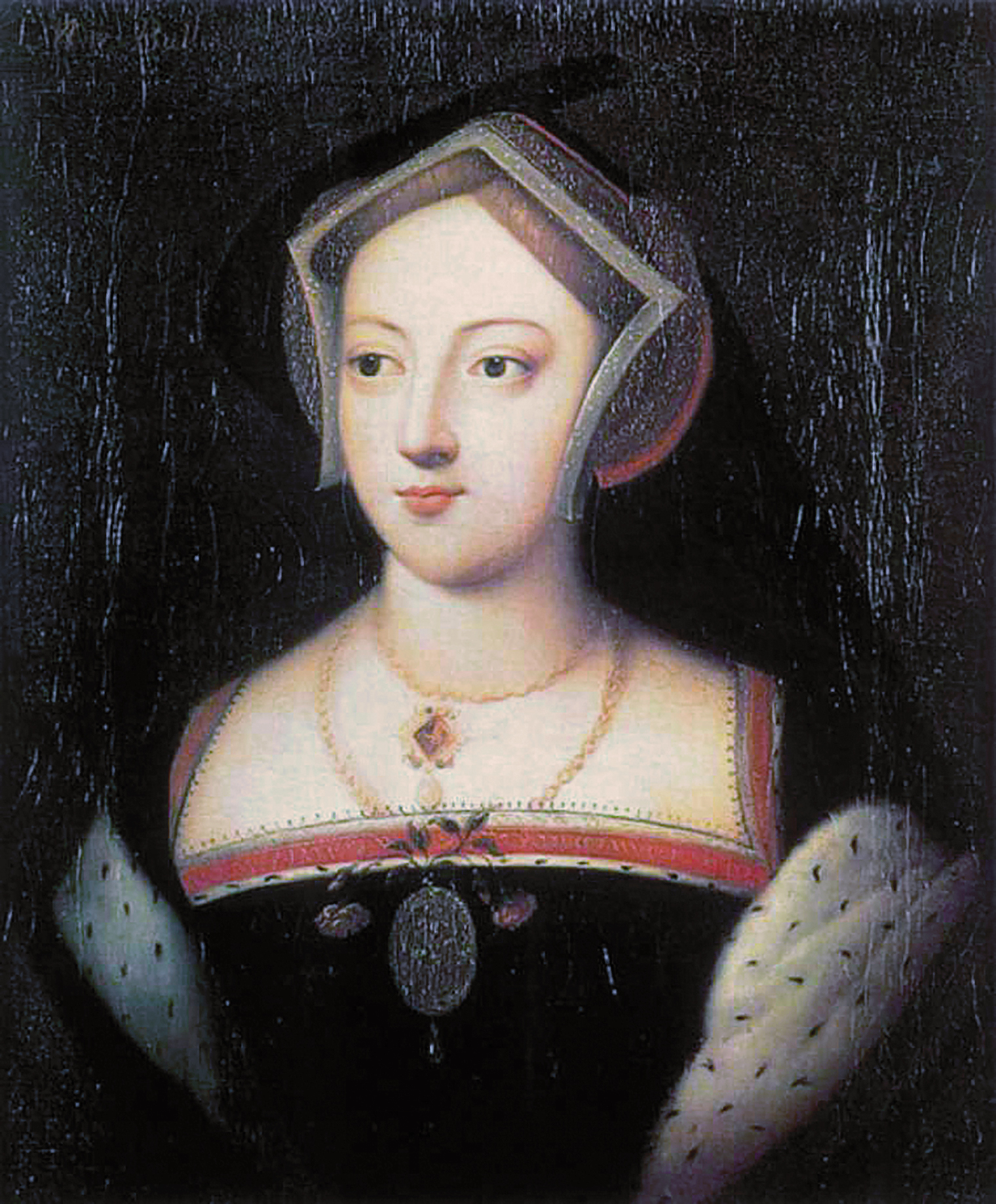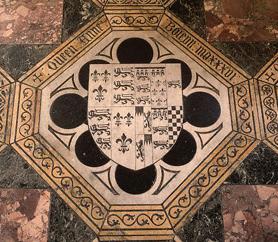by Susan Flantzer © Unofficial Royalty 2016

Credit – Wikipedia
Anne Boleyn was the second of the six wives of King Henry VIII of England, the mother of Queen Elizabeth I of England, and one of Henry VIII’s two beheaded wives. The date and place of Anne’s birth are uncertain. She was born sometime between 1501 – 1507 at either Blicking Hall in Norfolk or Hever Castle in Kent. Anne’s father was Thomas Boleyn (later 1st Earl of Wiltshire, 1st Earl of Ormond, 1st Viscount Rochford), a diplomat for King Henry VII and King Henry VIII. He was descended from Eustace II, Count of Boulogne who fought for William the Conqueror during the Battle of Hastings. “Boulogne” eventually was anglicized to “Boleyn.” Anne’s mother was Lady Elizabeth Howard, the eldest daughter of Thomas Howard, 2nd Duke of Norfolk. Elizabeth’s eldest brother was Thomas Howard, 3rd Duke of Norfolk, a prominent Tudor politician, and one of her other brothers was Lord Edmund Howard, the father of Catherine Howard, King Henry VIII’s fifth wife, his other beheaded wife. Through her mother, Anne was a descendant of King Edward I of England.
Anne had two siblings who survived childhood:
- Mary Boleyn (c. 1499 – 1543), mistress of King Henry VIII of England, married (1) William Carey, issue may be Carey’s or Henry VIII’s; (2) Sir William Stafford, possible issue
- George Boleyn, Viscount Rochford (c. 1504 – 1536), married Jane Parker, no issue; George was executed as one of Anne’s supposed lovers and his wife Jane was executed with Catherine Howard

Mary Boleyn; Credit – Wikipedia
In 1512, Anne’s father was appointed an ambassador to the court of Margaret of Austria, Regent of the Netherlands in Brussels, and he was accompanied by his three children. While in Brussels, Anne served as a maid of honor to Margaret of Austria. She then joined her sister Mary at the French court as a maid of honor to Mary Tudor, sister of King Henry VIII, who had married King Louis XII of France. When Mary Tudor returned to England after King Louis XII died, Anne stayed on at the French court, serving as a maid of honor to Queen Claude, the daughter of King Louis XII and the wife of his successor King François I. Anne returned to England in 1522 and was appointed a maid of honor to Catherine of Aragon, King Henry VIII’s first wife.
Anne was lively and vivacious and soon attracted admirers at the English court including King Henry VIII. Henry’s only surviving child with his wife Catherine of Aragon was a daughter. Henry was desperate for a male heir and thought that Anne could give him one. Anne refused to become Henry’s mistress as her sister Mary had. However, she continued to flirt with him and entered into an amorous correspondence with him. Meanwhile, Henry set into action the machinations that would annul his marriage to Catherine of Aragon. When Henry secretly married Anne on January 25, 1533, at the Palace of Westminster, she was already pregnant with her first child. On May 25, 1533, Thomas Cranmer, Archbishop of Canterbury declared Henry and Catherine’s marriage null and void and five days later, he declared Henry and Anne’s marriage valid.
There was a rush for Anne to be crowned as she was pregnant and there was some question about whether the child had been conceived before or after the marriage ceremony. Anne was quite unpopular and Henry VIII wanted to cement her status. Anne was crowned at Westminster Abbey on June 1, 1533.
Anne was pregnant three times, but only gave birth to one live child:
- Elizabeth I, Queen of England (September 7, 1533 – March 24, 1603), unmarried, no issue
- Stillborn son (August/September 1534)
- Miscarried son (January 29, 1536)
When Anne gave birth to her first child, a daughter Elizabeth, Henry was greatly disappointed and did not even attend Elizabeth’s christening. Anne soon found herself supplanted as she had done to Catherine of Aragon. Jane Seymour, one of her maids of honor, and eventually Henry’s third wife, attracted Henry’s attention starting in 1534. By late 1535, Anne was pregnant again. However, during a tournament in January 1536, Henry fell from his horse and was unconscious for hours. The stress resulted in premature labor, and Anne miscarried a son.
The loss of this son sealed Anne’s fate. Henry was determined to be rid of her, and her fall and execution were engineered by Thomas Cromwell, Henry’s chief minister. Many historians believe that the case charging Anne with adultery with her brother George Boleyn and four other men (Francis Weston, Henry Norris, William Brereton, and Mark Smeaton) was completely fabricated. Anne was arrested on May 2, 1536, and taken to the Tower of London. On May 14, 1536, Thomas Cranmer, Archbishop of Canterbury declared her marriage to Henry was null and void. Her trial, presided over by her uncle Thomas Howard, 3rd Duke of Norfolk, occurred at the Tower on May 15, 1536, and she was found guilty of adultery, incest, and high treason. On May 18, 1536, Anne’s brother and the four other men were executed. Anne’s execution was scheduled for May 19, 1536, on Tower Green. Henry arranged for an expert swordsman from Calais, France who used a sword rather than an ax. Before her execution, Anne made a speech to the crowd:
Good Christian people, I am come hither to die, for according to the law, and by the law I am judged to die, and therefore I will speak nothing against it. I am come hither to accuse no man, nor to speak anything of that, whereof I am accused and condemned to die, but I pray God save the king and send him long to reign over you, for a gentler nor a more merciful prince was there never: and to me he was ever a good, a gentle and sovereign lord. And if any person will meddle of my cause, I require them to judge the best. And thus I take my leave of the world and of you all, and I heartily desire you all to pray for me. O Lord have mercy on me, to God I commend my soul.
After saying goodbye to her ladies, Anne knelt down and a blindfold was tied over her eyes. Anne remained in an upright kneeling position and kept repeating, “Jesu receive my soul; O Lord God have pity on my soul.” With one stroke of the executioner’s sword, Anne was dead. Her body was placed in an oak chest and she was buried in an unmarked grave in the Chapel of St. Peter-ad-Vincula at the Tower of London. In 1876, Anne’s remains were identified during renovation work and her grave is now marked by a plaque on the chapel floor.

Plaque marking Anne Boleyn’s grave; Credit – Wikipedia
This article is the intellectual property of Unofficial Royalty and is NOT TO BE COPIED, EDITED, OR POSTED IN ANY FORM ON ANOTHER WEBSITE under any circumstances. It is permissible to use a link that directs to Unofficial Royalty.
England: House of Tudor Resources at Unofficial Royalty
